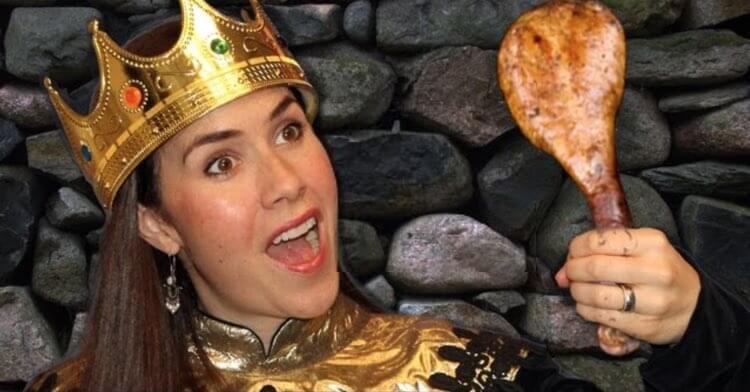Eat Alot of Bread Funny Video
Middle Ages Nutrient for poor and rich people differed profoundly, simply not in the way yous might think. Find out some interesting facts nigh what they really ate.
At Mama Natural, we talk a lot about eating unprocessed, real foods – like our smashing nifty grandmothers ate. Just what if we went back further? What if nosotros went back to… the Middle Ages?
Watch this fun video to see what people ate dorsum and so
Back in the Middle Ages in Europe, what you ate depended a lot on how rich you were.
Eye Ages nutrient for poor people revolved around barley
Barley bread, porridge, gruel and pasta, for breakfast, lunch and dinner.
Grain provided 65-seventy% of calories in the early 14th century.
Eye ages food for rich people included wheat and meat
Both of these items were expensive and prestigious.
Wild game was common, as was pork and chicken. Beef, which required lots of land, wasn't very big notwithstanding.
Vegetables were considered peasant food
So along with their grains, peasants ate cabbage, beets, onions, garlic and carrots.
Seasonings for upper-class people
Common seasonings for upper-class people included verjuice, wine and vinegar with black pepper, saffron and ginger. These, along with the widespread utilise of dearest, gave many dishes a sweet-sour flavor.
Almonds were mutual
Almonds were commonly used as a thickener in soups, stews, and sauces, and almond milk was hugely popular.
Cow milk, not so much
Cow milk wasn't popular because information technology spoiled and so quickly.
Cheese was kind of a large deal
Cheese was the most mutual source of animal protein for the lower classes, and many of the varieties would look familiar today, similar Edam, Brie and Parmesan.
What people cooked with
Butter was a popular cooking medium in Northern Europe – but it was super salty (5–10%) then information technology wouldn't spoil.
Other parts of Europe cooked with lard or oils of olive, poppy, walnut, and hazelnut.
Legume suspicion?
Legumes like chickpeas and fava beans were viewed with suspicion past the upper grade, in function because they cause flatulence.
But the regular folks chowed down on them.
Don't mess with that bread!
Since bread was so fundamental to the medieval nutrition, tampering with it or messing with weights was considered a serious offense. This gave rising to the "baker'south dozen": a baker would give 13 for the price of 12, to show they weren't adulterous.
Centre ages food: HOW PEOPLE ATE
In the eye ages, food and eating was very different.
Medieval Europeans typically ate ii meals a 24-hour interval: dinner at mid-twenty-four hours and a lighter supper in the evening.
During feasts, women often dined separately from men due to stupid social codes. Or, they sabbatum at the table and ate very piddling.
Plates were not-existent. Instead, people used the lesser office of a loaf of bread.
Or, in lower-class households they ate straight off the table.
At a big meal, spoons were provided, but it was bring your own knife.
Forks for eating weren't widely used until the early modern flow.
The church building had strict rules around eating. Consumption of meat was forbidden for a total third of the year for virtually Christians.
But, there were ways effectually this. Monks in particular raised rabbits considering the newborns were declared "fish" (or, at to the lowest degree, not-meat) by the church and thus could exist eaten during Lent.
Middle ages food: HOW MUCH?
In the Middle Ages, food was consumed at about 4,000 calories a day for peasants, merely they burned around 4,500 calories each twenty-four hours in manual labor.
Compare that to modern Americans, who eat about 3,000 calories a day merely fire but 2,000.
Medieval monks were a little more similar united states. They consumed 6,000 calories/day on "normal" days, and four,500 calories/day when fasting.
Needless to say, heart ages food meant the common people were sparse, while obesity was prevalent among monks and the upper classes.
Then once more, plump people were considered more attractive dorsum so.
In the Middle Ages, alcoholic beverages were always preferred over h2o, which could be contaminated.
Wine was regarded as the nearly prestigious and good for you choice, only the boilerplate person drank beer. A LOT of beer.
At Westminster Abbey, each monk was given an allowance of 1 gallon of beer per day.
Middle ages food: DESSERT
The term "dessert" originated during the Middle Ages.
Information technology started off as mulled wine anile cheese, but by the Late Middle Ages could likewise include fresh fruit covered in beloved or syrup and boiled-downward fruit pastes.
Sugar was less mutual and, from its showtime appearance in Europe, was viewed every bit much as a drug as a sweetener.
Which nutrition looks more like YOURS? The rich people's fare of meat and wheat? Or the more vegetarian diet of the poor?

Source: https://www.mamanatural.com/food-in-the-middle-ages/
0 Response to "Eat Alot of Bread Funny Video"
Post a Comment